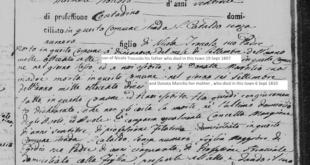About Italian Command Verbs
To speak fluently in another language, it is important to understand the nuances used among family members and friends. In Italian, verbs in their familiar imperative form are commonly used, especially with children, to give encouragement, instructions, or warnings. In many cases, a familiar imperative verb can stand alone as a complete expression.
To the English speaker, the grammatical name “imperative verb,” or its alternate “command verb,” can suggest a harsh approach to interacting with others; we English speakers typically think of a command as a type of forceful instruction given by an officer in the military, or maybe by one’s boss at work, or even a strict teacher at school. And yet, we do use this form in English every day with family and friends, often without realizing it. For instance, when we say, “Be careful!” we are issuing a command that arises out of concern for another. We use a shortened infinitive form of the English verb without a subject pronoun when giving a command in English. “To be” is shortened to “be” in our example sentence, and it is understood that the speaker is directly addressing another person or a group.*
As in English, if one knows an Italian infinitive verb, he or she is able to give an Italian command, although only in the negative. In Italian, verbs must be conjugated and their imperative endings used according to whom the speaker is addressing. But if we learn several common Italian expressions with their familiar command verbs, we will truly sound like a native Italian when speaking with family and friends!
*The proper conjugation of the English verb “to be” is: I am, you are, he/she is, we are, you all are, they are. Among certain groups in America, the word “be” can sometimes replace one of the usual conjugated forms of the verb “to be” in informal speech. In this case, the word “be” is spoken after a subject pronoun (“I be, you be, he/she be), although this is not considered grammatically correct.
****************************************
How to Create an Italian Command
By definition, the speaker using an imperative verb is giving a command to someone else. This means that there is no first person, or io conjugation, to learn; imperative verbs are conjugated only in the tu, Lei, noi and voi forms. We will not cover the polite Lei imperative in this blog, which is rendered only with the Italian subjunctive mood. This leaves us with the familiar second person singular and plural (tu/voi) forms and the noi form to discuss.
As we will see, the familiar command noi ending is identical to the present tense, although the meaning is different. For all but the -are verbs, the familiar command tu and voi verb endings are also identical to the present tense! The Italian subject pronoun is always omitted when relaying a familiar command and therefore in conversational Italian one must rely on the verb ending alone to understand the message.
Given their similarity to the present tense, Italian familiar command verbs must be taken in context during conversation. Italian commands are usually short and are spoken forcefully; in writing they are followed by an exclamation point to emphasize the command ending is being used.
The first table below shows the imperative endings for the -are, -ere, and -ire groups of Italian verbs. For the tu form, you will note from the red a that only the -are verbs have an imperative ending that differs from the simple present tense.
| Italian Imperative Tense Endings |
| –are | -ere | -ire | -ire(isc) | |
| (io) | – | – | – | – |
| tu | a | i | i | isci |
| Lei/lei/lui | ||||
| noi | iamo | iamo | iamo | iamo |
| voi | ate | ete | ite | ite |
| (loro) | – | – | – | – |
In the following table are three Italian verbs that are commonly used in the imperative tense.
Notice that the imperative noi form has endings that are identical to the present tense, although as mentioned previously, the meaning is “Let’s… (do something)“ when the verb is used in the imperative. Now, doesn’t it make sense that “Andiamo!” means, “Let’s go”? We are simply using the imperative form of the present tense! Check out the example verbs in the last table and their English translations.
| Guardare!(to look) | Rispondere!(to answer) | Partire!(to leave) | |
| tu | Guarda! Look! |
Rispondi! Answer! |
Parti! Leave! |
| noi | Guardiamo! Let’s look! |
Rispondiamo! Let’s answer! |
Partiamo! Let’s leave! |
| voi | Guardate! (You all) look! |
Rispondete! (You all) answer! |
Partite! (You all) leave! |
****************************************
Italian Imperative Verbs:
Italian Commands with Reflexive Verbs
When conjugating a reflexive verb into the familiar imperative, we must also know where to place the reflexive pronoun — which in this case is after the verb and attached to the end of the conjugated form. This rule holds true for the tu, noi, and voi forms. The conjugated verb and attached pronoun are spoken as one word.
This rule may seem confusing at first, since previously we have learned to put Italian reflexive pronouns before the verb. Although, the sequence is the same for English reflexive commands. We English speakers also put the reflexive pronoun after a command verb in English — when it is needed — so the Italian sentence structure should not be difficult to get used to.*
Try to remember the correct way to conjugate Italian reflexive imperative verbs from everyday experiences at home. For instance, think of some common phrases a mother might say to a teenager on a school morning : “Alzati!” for “Wake (yourself) up!” and “Sbrigati!” for “Hurry (yourself) up!” And, in Italian households, at dinnertime each person in the family is encouraged to, “Siediti!” for “Sit (yourself) down!” so everyone can start eating before the food gets cold!
Notice the spelling change for our example verb sbrigarsi for the noi form in the table below. The spelling change is necessary to keep the sound of this form constant with the infinitive form and other conjugated forms.
| Imperative Sbrigarsi – to hurry (oneself) up |
| tu | Sbrigati! | Hurry (yourself/familiar) up! |
| noi | Sbrighiamoci! | Let’s hurry ourselves up! |
| voi | Sbrigatevi! | Hurry (yourselves/familiar) up! |
*Remember that Italian uses reflexive verbs far more commonly than English does. Often in English uses a verb-preposition combination to render the same idea as Italian does with a reflexive verb. But think of the English examples, “Wash yourself right now!” or “Give yourself a chance!” to see that this is the case.
****************************************
Italian Imperative Verbs:
Common Irregular Italian Verbs
The imperative forms for seven important irregular Italian verbs are presented in the tables below. Notice that most of the verbs in the first table have two imperative tu forms. The more commonly used tu form is blue and is identical to the present tense. The irregular verbs avere and essere always use unique, irregular tu and voi command forms.
Anyone who enjoys watching Italian movies has heard the many ways there are in Italian to ask or tell someone to leave a place such as: “Va!” (“Go!”) or more forcefully, “Vai via!” (“Go away!”). By the way, lest we think Italians are rude when asking someone to leave, there is also a polite way to tell someone to leave, with the subjunctive verb — “Vada!” which also means, “Go!”
“Dai!” is used to encourage someone to continue on despite difficulty and means, “Come on!” You might also want to remember “Dimmi!” for “Tell me!” and “Dammi!” for “Give me!” When directing someone to get moving on a project, use “Fallo!” which means, “Do it!” Notice how the first letters of the direct objects mi and lo are doubled when writing these irregular command forms.
Finally, if you would like to direct a child to “Be good!” you can say, “Stai buono(a)!” or less commonly, “Stà buono(a)!” These sentences use the tu imperative form of the verb stare. Remember from our previous blog about buono that the ending of the adjective buono will change, depending on the gender of the person addressed. On the other hand, “Sei bravo(a)” means the speaker is addressing someone who is has done something well. When a parent wants to command their child to be patient, he or she may say, “Abbi pazienza!” for “Have patience!”
See the tables below for a summary of these important irregular verbs in the imperative tense. Imperative forms that differ from their present tense conjugation are given in brown. Some of these verbs can stand alone, while others need a pronoun or adjective to complete the sentence Look for the ellipse (…) in our tables and try to think of a complete command for each!
| Irregular Italian Imperative Verbs |
| Andare
(to go) |
Dare
(to give) |
Dire
(to say |
Fare
(to do |
Stare
(to be |
|
| tu | Vai! / Và! | Dai…! / Dà…! | Di…! | Fai…! / Fa…! | Stai…!/ Stà!…! |
| noi | Andiamo! | Diamo…! | Diciamo…! | Facciamo…! | Stiamo…! |
| voi | Andate! | Date…! | Dite…! | Fate…! | State…! |
| Avere
(to have) |
Essere
(to be) |
|
| tu | Abbi…! | Sii…! |
| noi | Abbiamo…! | Siamo…! |
| voi | Abbiate…! | Siate…! |
****************************************
Negative Italian Commands with
Common Irregular Italian Verbs
It is easy to give a familiar negative command to one person in Italian — that is, it is easy to tell someone you know not to do something! For all Italian verbs, simply put the word non in front of the infinitive form of the verb. In other words, do not conjugate!
The reflexive pronoun ti still needs to be tacked on to the end of the infinitive reflexive verb, though. For instance, if one friend wants to tell another, “Don’t worry!” the Italian is, “Non preoccuparti!” As usual for familiar imperative verbs, the subject pronoun tu is left out of the sentence. The additional verb “do” that we use in English before “not” — to make “do not” or “don’t” — is not necessary in Italian.
Below are examples that use the Italian verbs preoccuparsi (to be worried), guardare (to look) and parlare (to talk/speak). The Italian subject pronouns tu, noi, and voi are omitted from familiar command sentences but are given in parenthesis for reference. Notice that the subject pronoun is also omitted in English.
(tu) Non preoccuparti! Don’t (you fam.) worry yourself!
(tu) Non guardare! Don’t (you fam.) look!
(tu) Non parlare! Don’t (you fam.) speak!
For the negative imperative in the noi and voi forms, conjugate as usual and simply put non in front of the Italian verb. Remember to add the reflexive pronoun to the ending of all reflexive verbs. Again, the Italian and English subject pronouns are omitted.
(noi) Non preoccupiamoci! Let’s not worry ourselves!
(voi) Non preoccupatevi! (You all) Don’t worry yourselves!
(noi) Non guardiamo! Let’s not look!
(voi) Non guardate! (You all) Don’t look!
Remember how to use Italian command verbs
and I guarantee you will use these phrases
with family and friends every day!
For “All the Italian you need to enjoy your trip to Italy” click on the links for my Conversational Italian for Travelers books -Kathryn Occhipinti


 Fra Noi Embrace Your Inner Italian
Fra Noi Embrace Your Inner Italian






